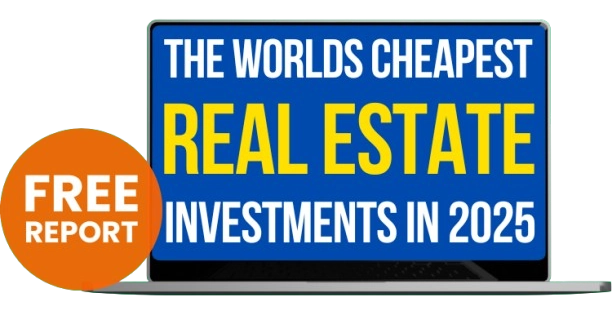If I were just starting out as an investor today, with little capital and an eye to converting that capital as quickly as possible into a diversified global property portfolio, where would I invest?
That’s the question I get from readers more than any other.
My answer likely will surprise you.
If I were setting out with this objective fresh today… or if I somehow lost everything I’ve built over the past 25 years and had to start over… where would I invest first?
The United States.
The average investor can access a high level of leverage in the United States, through bank mortgages and seller financing, that you generally can’t get anywhere else in the world.
Buy a rental property in the United States using borrowed funds, and the rent you earn can cover the mortgage payment. Meantime, you’re building equity in the property as you pay down the loan and as the market where the property is located appreciates (you hope).
In the United States, an investment in real estate can be accomplished through a straightforward, proven formula that has evolved into a mega-industry complete with late-night TV gurus who walk the uninitiated through their paces.
As a result, the United States is the best market in the world for getting started and converting a very modest amount of capital into a bona fide portfolio quickly. In truth, it could be the only market in the world where that’s possible.
Of course, the more leverage, the more risk. It can be easy to lose everything in U.S. property markets, because they’re uber-leveraged.
I was reminded of this fact this week by Argentine colleague Paul Reynolds. Paul pointed out that but 1% of the Buenos Aires property market is leveraged. This means that, despite the economic and financial crises this country has been enduring these past several years, the BA real estate market has not collapsed. Sellers may be eager and very open to offers, but they aren’t losing their properties… because they own their properties free and clear.
I began my property investing career in the United States. My first investment was in a three-flat building in Chicago that I was able to buy with all of US$5,000 down. I converted that US$5,000 into US$150,000 in two-and-a-half years… and it was that US$150,000 that I used to make my first property investment overseas.
So, if I had to start over, I’d return to the States and try to replicate that experience from two decades ago in Chicago. I’d work to build up US$50,000 to US$100,000 in investment capital… then I’d take that stake overseas.
Where would I head?
If I were just getting started at this today, I’d focus on these markets:
Why These Four Markets In Particular?
Because they all offer good property investment options for less than US$100,000.
In fact, you can buy in all of these markets today for as little as US$50,000.
Capital requirement is an important consideration for the just-starting-out global property investor.
In the Dominican Republic, a nonresident foreigner can get a local mortgage, meaning the capital requirement can be even lower.
Of course, you have to qualify for the mortgage, and the terms won’t be what you are used to back home. You’ll be looking at a loan-to-value (LTV) of no more than 80% and more likely 70% or less. In fact, though, the lesser LTV can be a good thing as it mitigates your leverage risk.
As well, interest rates won’t be what you’d expect in the States. You’ll likely be looking at 7% to 9%. You may be able to borrow for a term of up to 30 years, but more common in the rest of the world is a 20- to 25-year amortization period.
However, even with an interest rate of 9%, you can make a cash-flowing rental investment work in this market.
And, given current property appreciation rates in the Dominican Republic, you might be able to double your equity in that cash-flowing asset in three to five years.
It’s not possible for a foreign buyer to borrow locally for the purchase of real estate in Colombia or Brazil… and, while it’s possible in theory it’s very difficult in practice in today’s climate for a nonresident foreigner to borrow locally in Panama.
However, that is not to say you don’t have options for leverage in those markets.
In fact, you have two.
First, you can buy
pre-construction
.A pre-construction purchase allows you to make payments over the two- to three-year construction period, during which you should also enjoy appreciation on the value of the property.
Second, you can try to negotiate payment terms with the seller. This is more common today than ever and a possibility both with an individual owner and a developer. Indeed, this will be a focus at my 2019 Global Property Summit. I’ll be showcasing current investments that come with financing options, in some cases as good as I’ve seen, with small or even zero down payments and 0% interest.
And, in some cases, these special opportunities will be on offer for conference attendees only.
Another reason I like Colombia, Panama, the Dominican Republic, and Brazil as much as I do is because the property markets in these countries are fueled, in each case, by more than one set of buyers. Both foreign and local investors are taking positions in these markets… which are serving tourists, expats, retirees, second-home-overseas buyers, businesspeople, and investor
Buying-selling pools this diverse mean more liquid markets and more reliable rental yields.
In addition, all of these countries are enjoying fast-growing middle classes.This means, again, more market activity, both for sales and rentals… which means, again, greater liquidity and stronger rental returns.
Low entry prices, some leverage options, and growing and active marketplaces make Colombia, Panama, the Dominican Republic, and Brazil good options for someone looking to start an overseas property portfolio with limited capital.
Of course, all these markets… like all markets, period… come with risks.
Currency isn’t a risk in Panama (which uses the U.S. dollar as its currency) or the DR, where real estate, both for sale and for rent, is priced in U.S. dollars (and, in some cases in some tourist areas, in euro).
Right now, the
currency diversification
available in Colombia and Brazil is working in favor of the dollar-holder (both U.S. and Canadian). Of course, this will not last forever.
Another risk has to do with rental property investments specifically. What if demand falls off?
This is another reason I like these four markets. All enjoy strong rental demand that I don’t see diminishing anytime soon. Furthermore, in each case, the demand for rental accommodation comes from diverse sources, hedging your risk. If one source of demand diminishes (European tourists, say), you still have other options for finding tenants for your rental properties (local tourists, for example).
If I were starting over today with limited resources, I’d hightail it to Colombia, Panama, the Dominican Republic, or Brazil.
If I had the time and the budget, I’d take a position in all four.
And I’d do it now… while these markets remain the “perfect storm” markets I perceive them to be.
Lief Simon










